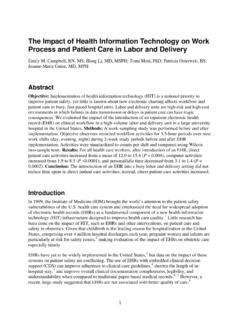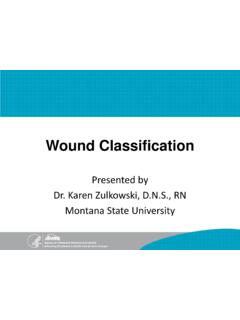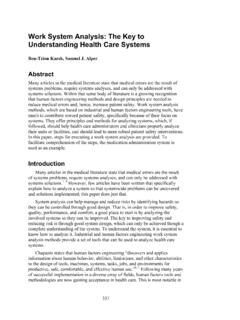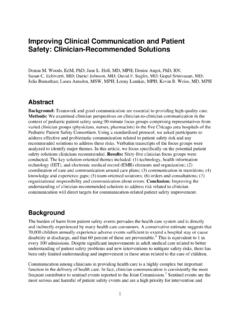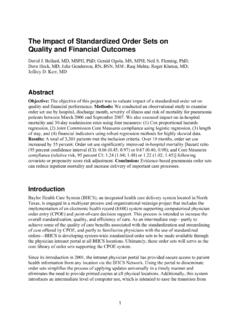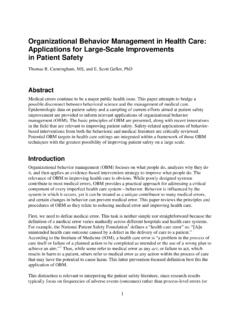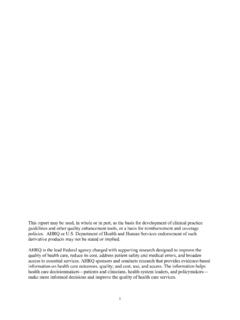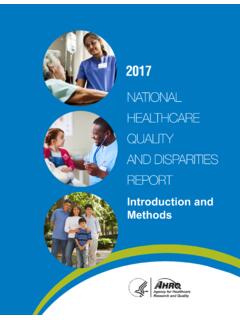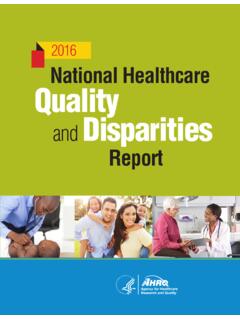Transcription of The Guide to Clinical Preventive Services 2014
1 The Guide to Clinical Preventive Services2014 The Clinical summaries in the Guide are abridged versions of recommendations from the Preventive Services Task Force (USPSTF). To view the full recommendation statements, supporting evidence, or recommendations published after March 2014, go to USPSTF Electronic Preventive Services Selector (ePSS) allows users to download the USPSTF recommendations to PDA, mobile, or tablet devices; receive notifications of updates; and search and browse recommendations online. Users can search the ePSS for recommendations by patient age, sex, and pregnancy status. To download, subscribe, or search, go to made by the USPSTF are independent of the Government.
2 They should not be construed as an official position of AHRQ or the Department of Health and Human Guide to Clinical Preventive Services2014 Recommendations of the Preventive Services Task ForceiiiForewordSince 1998, the Agency for Healthcare Research and Quality (AHRQ) has convened the Preventive Services Task Force (USPSTF) an independent, volunteer panel of national experts in prevention and evidence-based medicine. The Task Force makes recommendations to help primary care clinicians and patients decide together whether a Preventive service is right for a patient s needs. AHRQ staff provide scientific and administrative support for the Task Force, and assist in disseminating its findings and recommendations to key audiences.
3 In that role, we are pleased to make The Guide to Clinical Preventive Services 2014 available to those who seek to ensure that their patients receive the highest quality Clinical Preventive Services . I am gratified that AHRQ has been able to support the USPSTF in its efforts to engage the public and to ensure that its processes are transparent. Most notably, all Task Force draft materials are now available for public comment online at Previous iterations of the USPSTF Guide to Clinical Preventive Services are used around the Nation to provide appropriate and effective Preventive care. The Guide is designed to be user-friendly for practicing clinicians. In addition, the Guide lists resources that clinicians can use to educate their patients on appropriate Preventive Services , such as Stay Healthy brochures and MyHealthfinder (see Appendixes).
4 Also included are brief descriptions of and links to tools that health care professionals can use to improve their practice, including the electronic Preventive Services Selector (ePSS) and the National Guideline Clearinghouse (see Appendixes). As more information becomes available to clinicians and patients alike, AHRQ s goal is to help improve patients health and well-being, and contribute to better health outcomes for the Nation Kronick, Director Agency for Healthcare Research and QualityvPrefaceThe Preventive Services Task Force (USPSTF) is mandated by Congress to conduct rigorous reviews of scientific evidence to create evidence-based recommendations for Preventive Services that may be provided in the primary care its inception, the USPSTF has made and maintained recommendations on dozens of Clinical Preventive Services that are intended to prevent or reduce the risk for heart disease, cancer, infectious diseases, and other conditions and events that impact the health of children, adolescents, adults, and pregnant women.
5 The Guide to Clinical Preventive Services 2014 includes both new and updated recommendations released from 2004-2014 in a brief, easily usable format meant for use at the point of patient care. The most up-to-date version of the recommendations, as well as the complete USPSTF recommendation statements, are available along with their supporting scientific evidence at Recommendations for Preventive care have evolved over time as it has become widely recognized that some Preventive Services were not actually beneficial. Individual health care providers, professional organizations, integrated health systems, insurers (both private and public), as well as groups crafting health quality measures and national health objectives , have recognized the need to carefully balance potential benefits and harms using the highest quality of evidence, and have adopted the recommendations of the Task Force.
6 The primary audience for the USPSTF s work remains primary care clinicians, and the recommendations are now considered by many to provide definitive standards for Preventive Services . The work of the USPSTF is recognized by the Patient Protection and Affordable Care Act. Under the law, Preventive Services with a Task Force grade of A or B must be covered without cost-sharing ( , copayment or deductible) under new health insurance plans or policies. In the last several years, the USPSTF has increased the transparency of its work, and these efforts have gained additional momentum in view of the enhanced importance of the recommendations under the new law. Public comments are welcomed at multiple points in the development of each recommendation to encourage additional input from experts, advocates and other stakeholders to help the Task Force craft relevant and clear recommendation statements.
7 However, the USPSTF remains committed to evaluating evidence free from the influence of politics, special interests, and advocacy. As the science around Clinical practice guideline development has evolved, USPSTF methods continue to evolve as well. The Procedure Manual, which can be found on vithe USPSTF Web site, details the most updated version of the process for evaluating the quality and strength of the evidence for a service, determining the net health benefit (benefit minus harms) associated with the service, and judging the level of certainty that providing these Services will be beneficial in primary care. We continue to explore the appropriate use of mathematical modeling to help fill research gaps regarding the ages at which to start and stop providing a service, and at what time intervals.
8 In addition, we are committed to improving the communication of our recommendations to a broader audience, including patients and letter grade linked to each recommendation reflects both the magnitude of net benefit and the strength and certainty of the evidence supporting the provision of a specific Preventive service. These grades translate to practice guidance for clinicians: Discuss Services with A and B recommendation grades with eligible patients and offer them as a priority. Discourage the use of Services with D recommendation grades unless there are unusual additional considerations. Give lower priority to Services with C recommendation grades; they need not be provided unless there are individual considerations in favor of providing the service.
9 Help patients understand the uncertainty surrounding Services with I (insufficient evidence) statements, which reflect the conclusion that the evidence is insufficient to determine net benefit. The Clinical Considerations section of each full recommendation statement offers additional USPSTF recognizes that Clinical decisions about patients involve more complex considerations than the evidence alone; clinicians should always understand the evidence but individualize decisionmaking to the specific patient and situation. The Clinical Considerations section of each USPSTF recommendation statement helps clinicians by offering practical information so they can tailor these recommendations to individual patients.
10 We strongly encourage clinicians to visit the USPSTF Web site and read the complete recommendation statements for Services relevant to their patients. Additional information is available to facilitate the delivery of the highest quality Preventive care. For each topic, educational materials have been developed for use with patients and the public. Special materials developed for clinicians are also available on some complex topics, such as prostate and lung cancer screening, along with links to informative Web sites. In addition, the USPSTF Electronic Preventive Services viiSelector (ePSS), available via PDA, smart phone, or on the Web at , allows users to search USPSTF recommendations by patient age and other Clinical hope you find the Guide to Clinical Preventive Services 2014 to be a useful tool as you care for patients.

